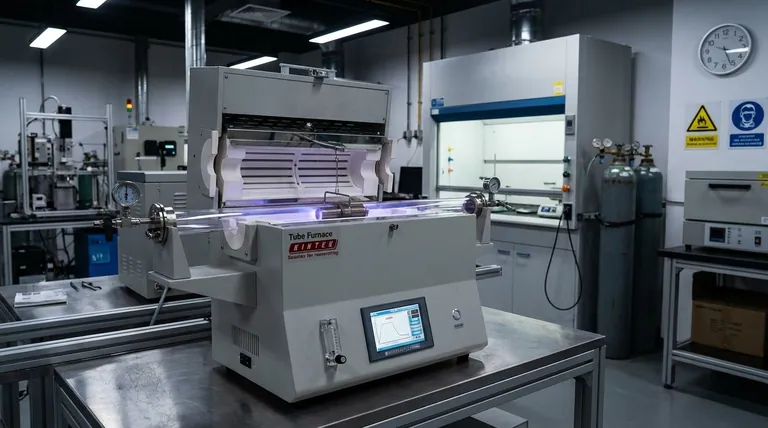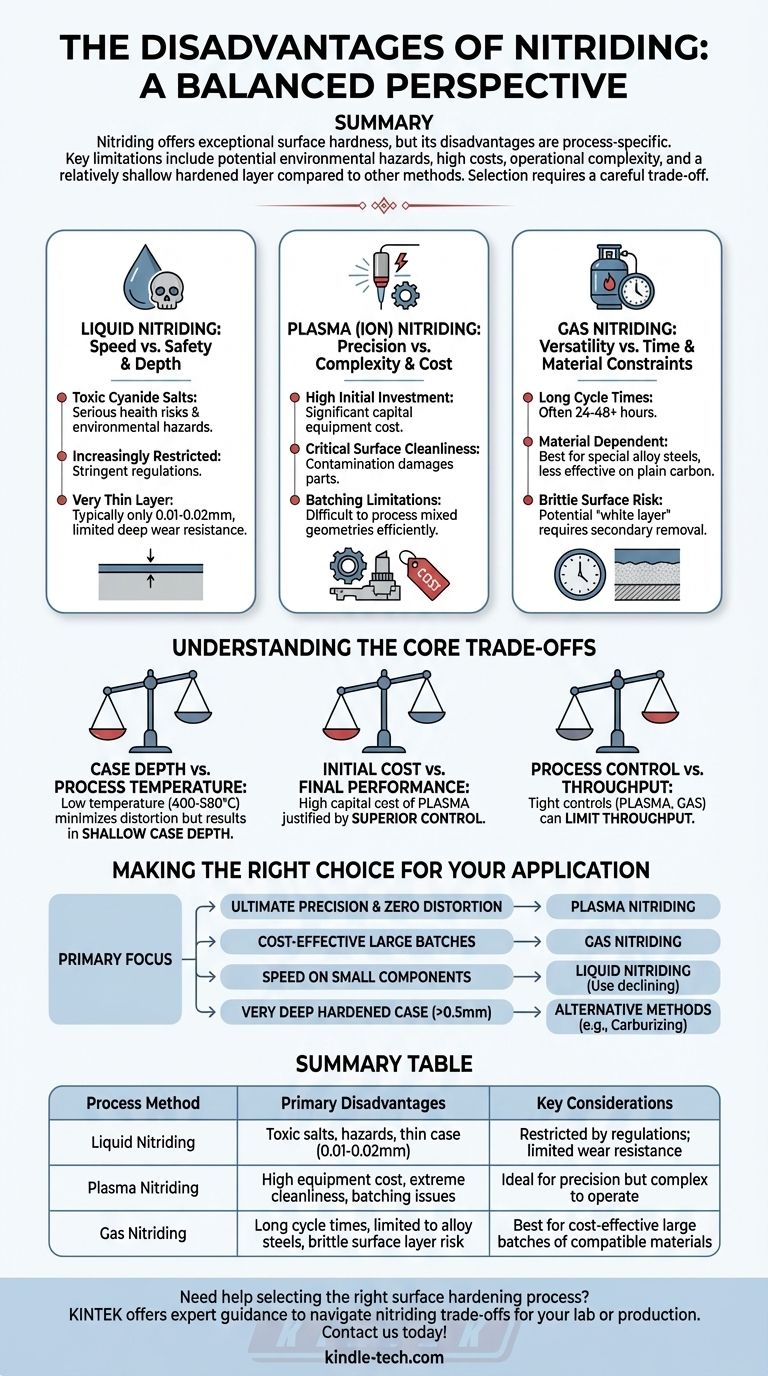간단히 말해, 질화 처리의 주요 단점은 공정별 한계입니다. 여기에는 액체 질화의 잠재적 환경 위험, 플라즈마 질화의 높은 초기 비용 및 복잡한 작동, 그리고 다른 표면 경화 방법에 비해 상대적으로 얇은 경화층 생성이 포함됩니다. 이러한 단점은 질화 공정 선택 시 비용, 성능 요구 사항 및 작동 제약 간의 신중한 절충이 필요함을 의미합니다.
질화 처리는 최소한의 부품 변형으로 탁월한 표면 경도와 내마모성을 제공하지만, 그 효과가 보편적이지는 않습니다. 단점은 선택한 특정 방법(액체, 가스 또는 플라즈마)에 따라 크게 달라지며, 프로젝트의 특정 재료, 예산 및 성능 목표와 비교하여 고려해야 합니다.

공정별 단점: 모든 질화 처리가 동일하지는 않습니다
"질화"라는 용어는 여러 가지 독특한 산업 공정을 포함합니다. 단점은 일반적으로 일반적이지 않으며, 대부분 평가 중인 특정 방법에 연결되어 있습니다.
액체 질화: 속도 대 안전 및 깊이
액체 질화는 속도로 알려져 있지만 상당한 절충이 따릅니다. 주요 단점은 많은 전통적인 제형에서 유독성 시안화물 염을 사용한다는 것입니다.
이는 작업자에게 심각한 건강 위험을 초래하고 폐기물 처리에 상당한 환경 문제를 야기합니다. 이러한 우려로 인해 비독성 대안이 개발되었음에도 불구하고 이 공정은 규제에 의해 점점 더 제한되고 있습니다.
또한, 액체 질화는 일반적으로 매우 얇은 경화층(종종 0.01-0.02mm에 불과)을 생성하며, 이는 더 깊은 내마모성을 요구하는 응용 분야에는 충분하지 않을 수 있습니다.
플라즈마 (이온) 질화: 정밀도 대 복잡성 및 비용
플라즈마 질화는 탁월한 제어 기능을 제공하지만 기술적 및 재정적 장애물을 야기합니다. 가장 중요한 것은 많은 작업에 장벽이 될 수 있는 플라즈마 장비에 대한 높은 초기 투자입니다.
공정 자체도 까다롭습니다. 부품 표면의 청결도는 절대적으로 중요합니다. 오염은 불안정한 전기 아크를 유발하여 부품을 손상시킬 수 있습니다.
작동상 배치에 제한이 있습니다. 전력 대 표면적 관계의 물리적 특성 때문에 서로 다른 크기나 형상의 부품을 단일 배치로 처리하기 어렵습니다. 이는 처리량 효율성을 감소시킵니다.
가스 질화: 다용도성 대 시간 및 재료 제약
가스 질화는 널리 사용되는 방법이지만 자체적인 문제점이 없는 것은 아닙니다. 가장 주목할 만한 단점은 긴 주기 시간으로, 종종 24-48시간 이상으로 연장될 수 있어 다른 방법보다 느립니다.
이 공정은 또한 처리되는 재료에 따라 달라집니다. 알루미늄, 크롬, 몰리브덴과 같은 질화물 형성 원소를 포함하는 특수 합금강에 가장 잘 작동합니다. 일반 탄소강에는 훨씬 덜 효과적입니다.
공정 매개변수가 정밀하게 제어되지 않으면 가스 질화는 표면에 취성 "백색층"을 생성할 수 있으며, 이는 2차 연삭 또는 래핑 작업을 통해 제거해야 할 수 있습니다.
핵심 절충점 이해하기
표면 경화 공정을 선택하려면 본질적인 한계를 인정해야 합니다. 질화의 경우 주요 절충점은 깊이, 비용 및 작동 현실에 중점을 둡니다.
경화 깊이 대 공정 온도
질화는 저온 공정(일반적으로 400-580°C)으로, 변형을 최소화한다는 것이 가장 큰 장점입니다. 그러나 이 저온은 또한 질소 확산 속도를 제한하여 고온 공정(예: 침탄)에 비해 상대적으로 얕은 경화 깊이를 초래합니다.
초기 비용 대 최종 성능
플라즈마 질화 시스템의 높은 초기 자본 비용은 케이스 특성에 대한 우수한 제어 필요성과 변형 없이 복잡한 형상을 처리할 수 있는 능력으로 정당화되어야 합니다. 일부 변형이 허용되는 더 간단한 부품의 경우 덜 비싼 방법이 더 경제적일 수 있습니다.
공정 제어 대 처리량
플라즈마 질화(청결도, 배치) 및 가스 질화(분위기 제어)에 필요한 엄격한 제어는 처리량을 제한할 수 있습니다. 이는 액체 질화의 더 빠르지만 더 위험하고 덜 정밀한 특성과 대조됩니다.
귀하의 응용 분야에 적합한 선택
올바른 질화 방법을 선택하거나 대안을 선택하는 것은 전적으로 귀하의 주요 목표에 달려 있습니다.
- 최소한의 변형으로 복잡한 부품에 대한 궁극적인 정밀도가 주요 초점이라면: 높은 초기 비용을 정당화하고 작동 복잡성을 관리할 수 있다면 플라즈마 질화가 우수한 선택입니다.
- 적합한 합금강 대량 배치에 대한 비용 효율적인 처리가 주요 초점이라면: 생산 일정이 긴 주기 시간을 수용할 수 있다면 가스 질화가 가장 균형 잡힌 옵션인 경우가 많습니다.
- 소형 부품의 속도가 주요 초점이고 엄격한 환경 통제 하에 운영된다면: 액체 질화도 고려할 수 있지만, 심각한 건강 및 안전 문제로 인해 사용이 감소하고 있습니다.
- 매우 깊은 경화층(>0.5mm)을 얻는 것이 주요 초점이라면: 질화는 근본적으로 얕은 케이스 방법이므로 침탄과 같은 대체 표면 경화 공정을 평가해야 합니다.
이러한 한계를 이해하는 것이 질화의 강력한 이점을 효과적으로 활용하기 위한 첫 번째 단계입니다.
요약표:
| 공정 방법 | 주요 단점 | 주요 고려 사항 |
|---|---|---|
| 액체 질화 | 유독성 시안화물 염, 환경 위험, 매우 얇은 경화 깊이 (0.01-0.02mm) | 규제에 의해 점점 더 제한됨; 제한된 내마모성 |
| 플라즈마 질화 | 높은 초기 장비 비용, 극도의 표면 청결도 요구, 어려운 배치 처리 | 정밀도에 이상적이지만 작동이 복잡함 |
| 가스 질화 | 긴 주기 시간 (24-48+시간), 특정 합금강으로 제한됨, 취성 표면층 위험 | 호환 가능한 재료의 비용 효율적인 대량 배치에 가장 적합함 |
귀하의 실험실 또는 생산 요구 사항에 적합한 표면 경화 공정을 선택하는 데 도움이 필요하십니까? KINTEK은 실험실 장비 및 소모품을 전문으로 하며, 질화 및 기타 방법의 장단점을 탐색하는 데 도움이 되는 전문가 지침을 제공합니다. 재료 제약, 예산 고려 사항 또는 성능 요구 사항을 다루든 관계없이, 우리는 운영 효율성을 향상시키기 위한 맞춤형 솔루션을 제공합니다. 오늘 저희에게 연락하여 귀하의 프로젝트에 대해 논의하고 KINTEK이 귀하의 실험실 목표를 어떻게 지원할 수 있는지 알아보십시오!
시각적 가이드

관련 제품
- 1400℃ 실험실용 알루미나 튜브 머플로
- 알루미나 튜브가 있는 1700℃ 실험실 석영 튜브 퍼니스 튜브 퍼니스
- 수직 실험실 석영 튜브 퍼니스 튜브형 퍼니스
- 진공 열처리로 및 부유 유도 용해로
- 스파크 플라즈마 소결로 SPS로



















